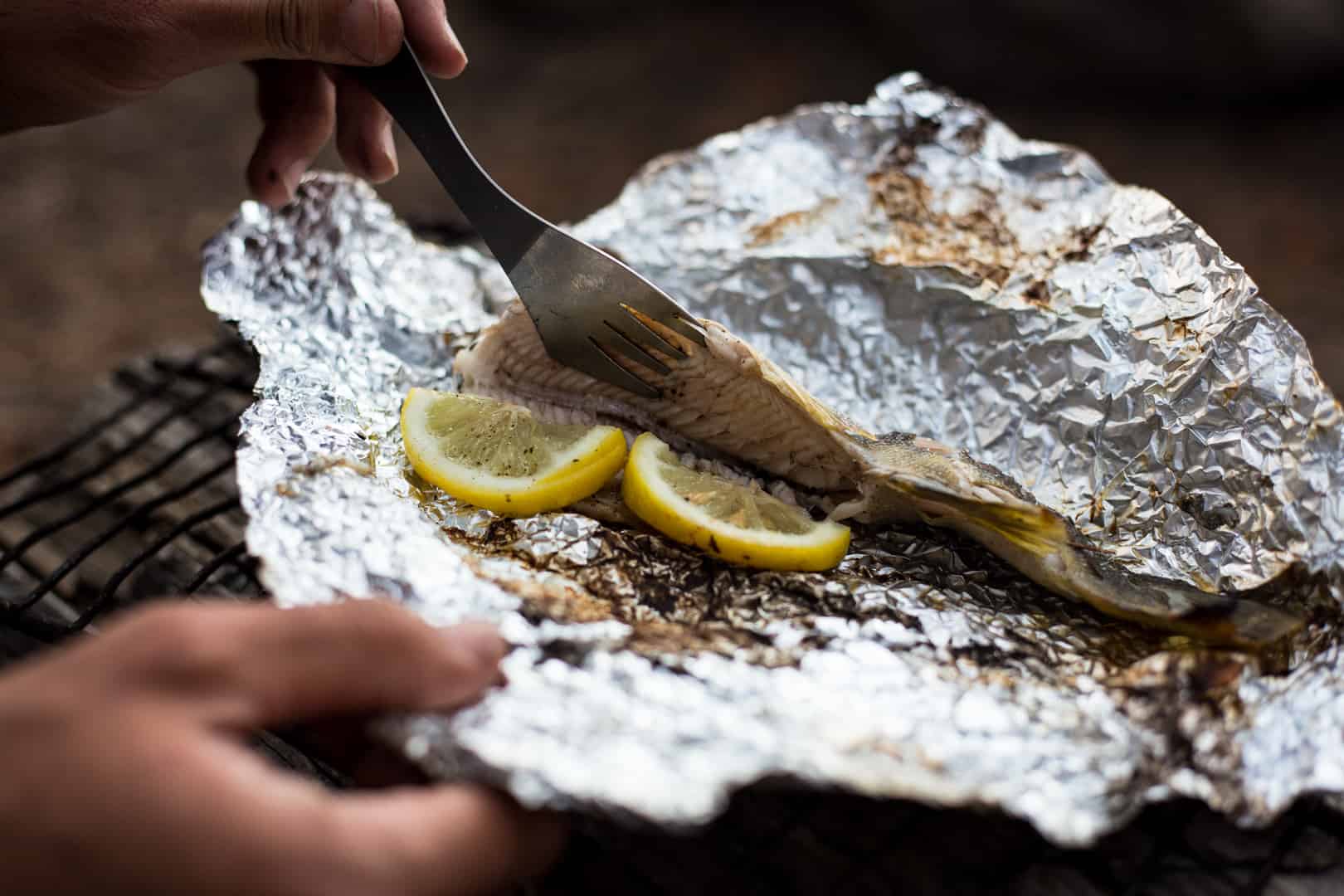

Emigrant Wilderness
Think of Emigrant Wilderness as Yosemite’s forgotten little brother. Bordering its more famous sibling to the north, this high country is defined by granite walls, domes, ridges, peaks and the meadows, creeks, and lakes that lay in their shadows. It is a backpacker’s paradise, offering soft trails, beautiful campsites and the opportunity to have a fire in the backcountry — a rarity in California. The fishing is excellent, too. Anglers will have the chance to catch trophy-sized trout deep in the High Sierra wilderness. Pitch your tent here for a night or two and you will fall in love.
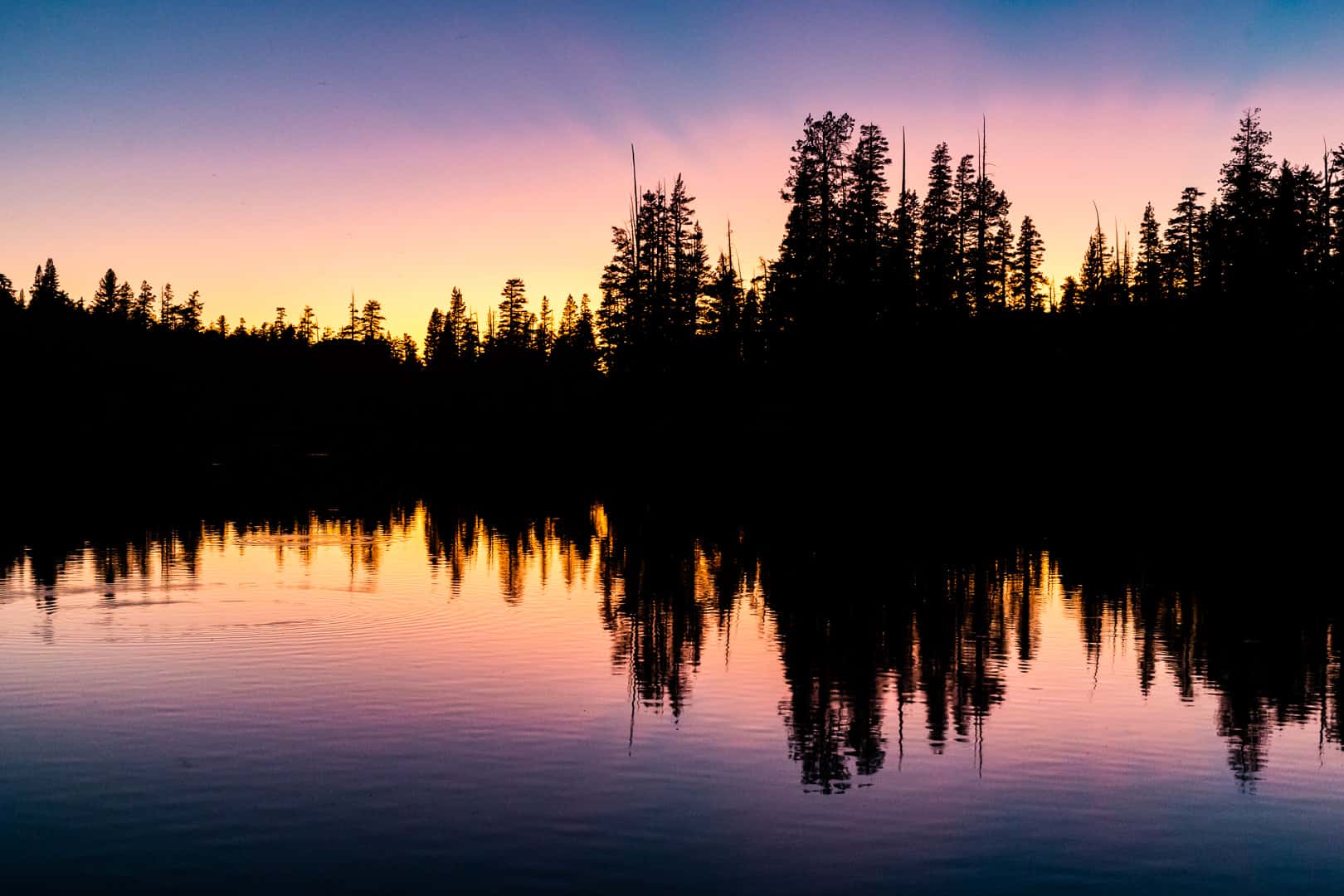
ABOVE: Pink hour at Wood Lake in the heart of the Emigrant Wilderness high country. I’ve noticed this phenomenon up here a few times now. I think it has to do with all the exposed granite that defines this landscape. After the sun dips below the horizon, its rays refract through the atmosphere, which filters out all but the pink/magenta light. That light then bounces off all the granite domes, ridges and walls, causing the whole area to glow pink for a few minutes. That’s my guess, anyway. And it’s not like a colorful sunset where the sky or clouds turn pink — it’s the actual light here that changes color. It’s really something to see.

LEFT: The half hour or so after the trout stop jumping and the day’s last light lingers in the sky, fading slowly from blue to black. This is blue hour along Kennedy Creek in the spectacular Emigrant Wilderness. Backpackers hiking into this area will find fish aplenty, not to mention fine campsites where they can start a fire and grill their catch.

ABOVE: The Milky Way unfurls over the heart of Emigrant Wilderness and the Sierra Nevada — a stargazer’s paradise. Just look at all that light. Upon closer inspection, it turns out it’s not so dark out there after all.
What to Take Backpacking in the High Sierra
Here’s everything I pack for a 3 or 4 night trip, minus food and water. I’d consider this list of base gear to be on the robust side — it will prepare you nicely for the unpredictability of the high country and guarantee a solid level of safety and comfort.
Deer Lake


ABOVE AND LEFT: Deer Lake, around 11 miles from the Crabtree Trailhead, is an excellent place to set up camp — especially if you’re a fisherman. You’ll find rainbow trout rising to insects in the mornings and evenings, but be warned: they’re spooky and difficult to catch. The lake is situated in a canyon that runs from West to East, so the sun hits the water longer than usual as it sets, delaying dinner time for the fish. We caught a nice rainbow here that we wrapped in foil and cooked over a fire for dinner — it was outstanding. There are some nice campsites on the north side of the lake and plenty of other lakes nearby, including Wood Lake and the Buck Lakes.
Backpacking Emigrant Wilderness

ABOVE: Emigrant Wilderness offers spectacular campsites, like this one in the vicinity of Bear Lake. This is actually one of the worst sites I’ve had up here (relatively speaking of course) as it was more than a bit exposed. Just poke around, though, and you’ll find plenty of beautiful sites tucked into the pines.
Timelapse
A Smoky Night in Emigrant Wilderness
A vivid night sky turns quickly into a smoky morning along Kennedy Creek in Emigrant Wilderness, with the Donnell Fire raging a few miles away.

ABOVE: My buddy Hergy at our campsite along Kennedy Creek. We used this spot as a basecamp to fish up and down the valley, including Kennedy Lake, where we had good luck catching some nice brown trout. Every evening we spent at this site, we’d walk down the bank to cook and eat dinner on the rocks along the creek. We’d dig into our freeze-dried beef stroganoff, with our rods strung and ready nearby, waiting for the trout to rise. And rise they did — we always managed to catch one or two before they stopped feeding.

ABOVE: Another amazing campsite not far from a beautiful lake deep in the Emigrant Wilderness backcountry. We spent a couple of nights here, fishing in the mornings and evenings, and relaxing in the shade during the day. Firewood was ample, the stars were brilliant and the nights were cool and quiet. Spots like these are a defining characteristic of this wilderness. Somehow, you just feel at home up here.

ABOVE: Camp along Piute Creek during our first night on the Emigrant Loop Trail. We had hoped to go a littler farther, but our legs were weary and we were in no rush.
Granite Everywhere

ABOVE: Take a peak at any decent map or satellite image of Emigrant Wilderness and you’ll quickly recognize that its most dominant feature is granite. This igneous rock is everywhere, in the shape of walls, ridges, domes and peaks. We often found ourselves exposed to the harsh high-country sun while hiking the Emigrant Loop Trail, or even climbing up to Kennedy Lake, so be sure to bring sunscreen, hats and buffs.
Fishing Emigrant Wilderness


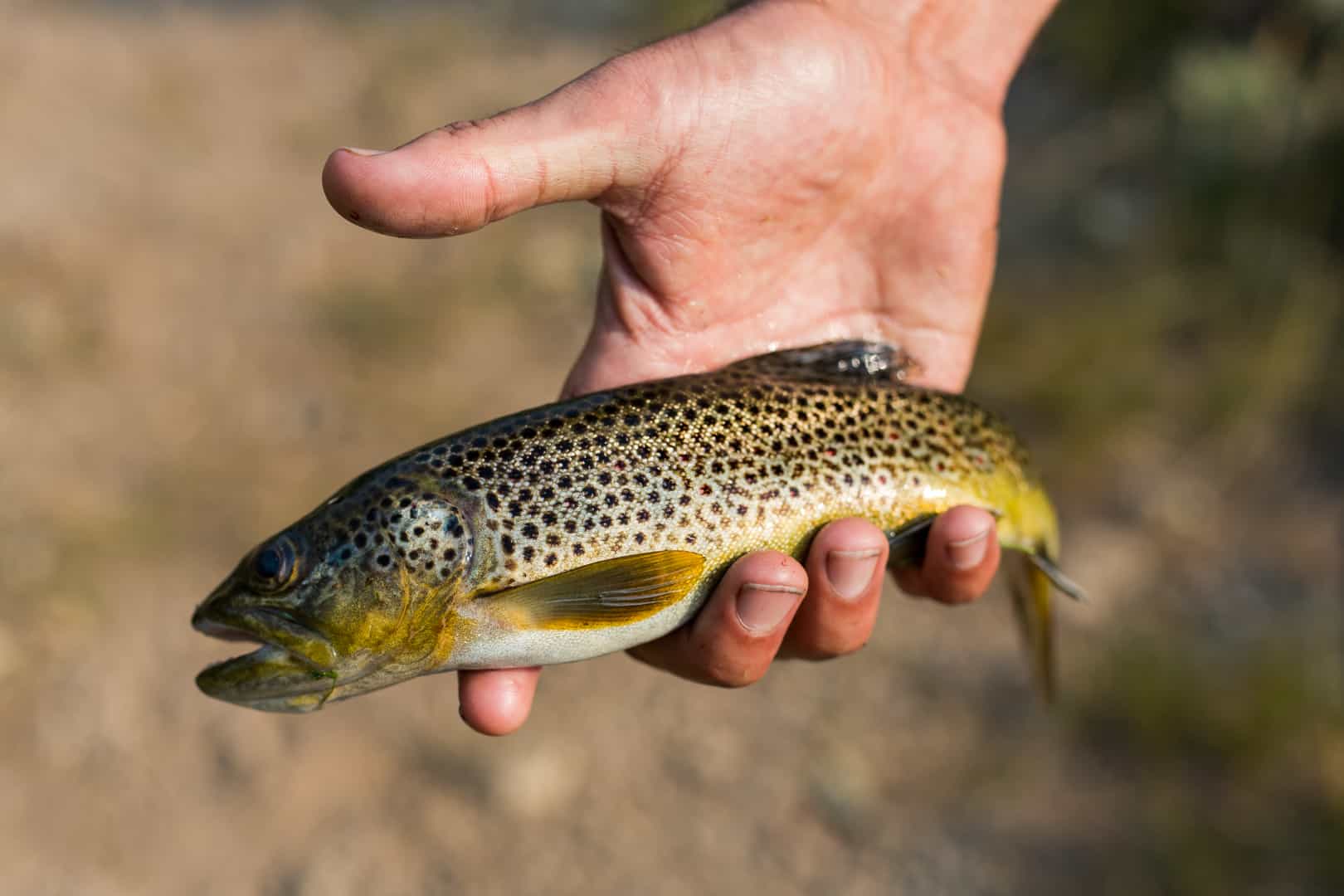
ABOVE: Hergy fishes Kennedy Lake as smoke from the Donnell Fire drifts up and down the valley. The fishing was solid here — plenty of nice browns rising to dry flies. We figured the smoky, overcast conditions were in our favor, at least as far as the fishing was concerned. In general, trout fishing is excellent in Emigrant Wilderness. You do have to do a little research before you go, though, as many lakes are fishless, which is pretty much the norm in the High Sierra. This wilderness harbors trophy fish for those willing to trek deep into the backcountry.
Photo Essay
The Brown Trout
A brown trout is caught, cleaned and cooked to perfection in the Emigrant Wilderness backcountry in California’s Sierra Nevada.
Wood Lake

ABOVE: We spent our last night on the Emigrant Loop Trail here, at Wood Lake (the same lake in the pink hour photograph at the beginning of this page). If I had to do it all over again, I’d spend at least another night here. We had the most amazing campsite in a grove of pines, with good access to the lake, where I cast to constantly rising trout. Wood Lake has a reputation for giving up big rainbows, but I was skunked — my rusty casts were no match for the spooky fish, especially with the water this calm. I’ll get ’em next time.
Kennedy Valley
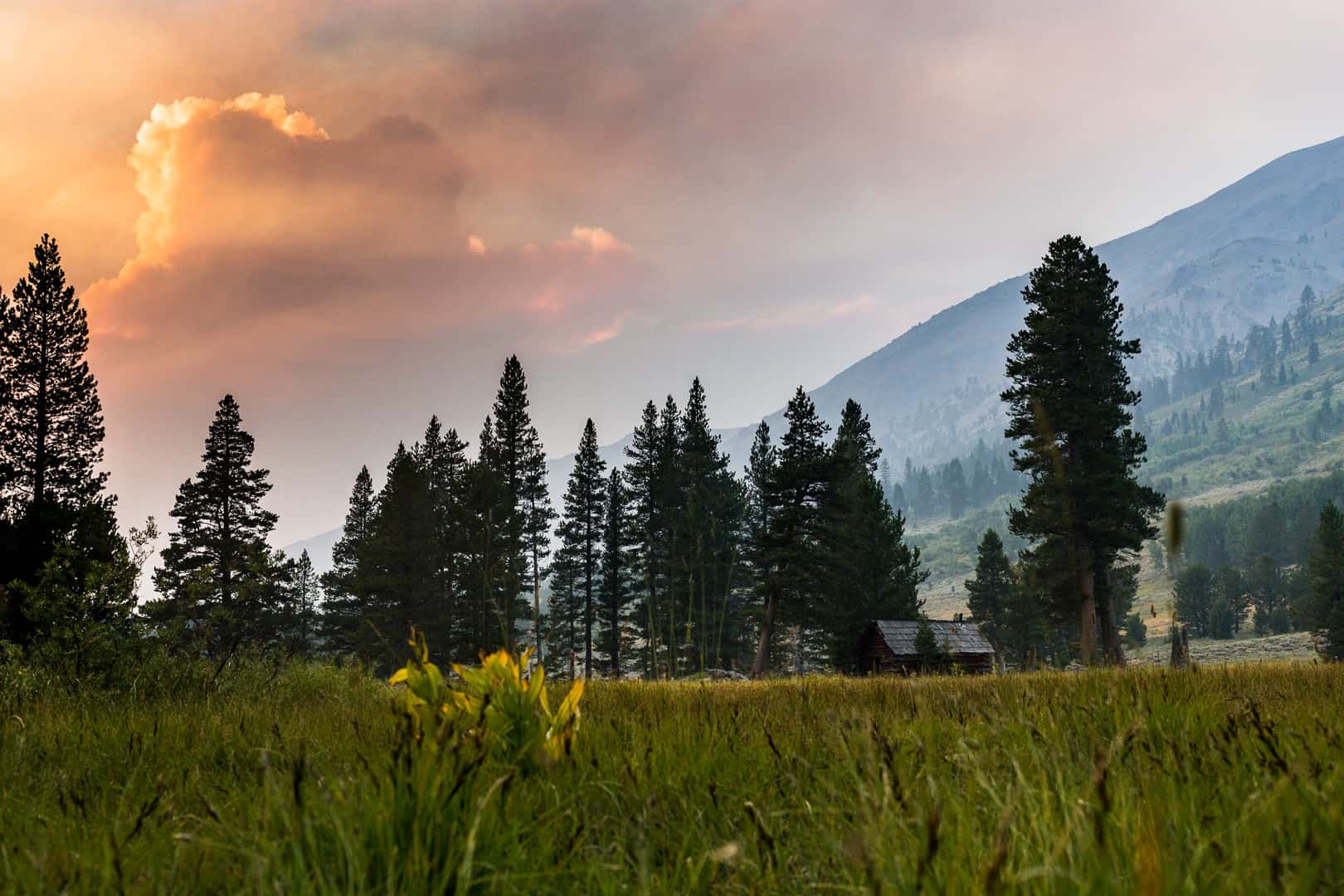
ABOVE: The view down Kennedy Valley in Emigrant Wilderness as a pyrocumulus cloud from the Donnell Fire looms beyond. I highly recommend an overnight trip into this scenic valley, lined by tall peaks along its entire length. You’ll see plenty of other backpackers, pack trains, and even some cows, as ranchers are allowed to graze their cattle in certain areas of the wilderness.

Pink hour at Wood Lake in the heart of the Emigrant Wilderness high country. I’ve noticed this phenomenon up here a few times now. I think it has to do with all the exposed granite that defines this landscape. After the sun dips below the horizon, its rays refract through the atmosphere, which filters out all but the pink/magenta light. That light then bounces off all the granite domes, ridges and walls, causing the whole area to glow pink for a few minutes. That’s my guess, anyway. And it’s not like a colorful sunset where the sky or clouds turn pink — it’s the actual light here that changes color. It’s really something to see.

The half hour or so after the trout stop jumping and the day’s last light lingers in the sky, fading slowly from blue to black. This is blue hour along Kennedy Creek in the spectacular Emigrant Wilderness. Backpackers hiking into this area will find fish aplenty, not to mention fine campsites where they can start a fire and grill their catch.

The Milky Way unfurls over the heart of Emigrant Wilderness and the Sierra Nevada — a stargazer’s paradise. Just look at all that light. Upon closer inspection, it turns out it’s not so dark out there after all.
Deer Lake
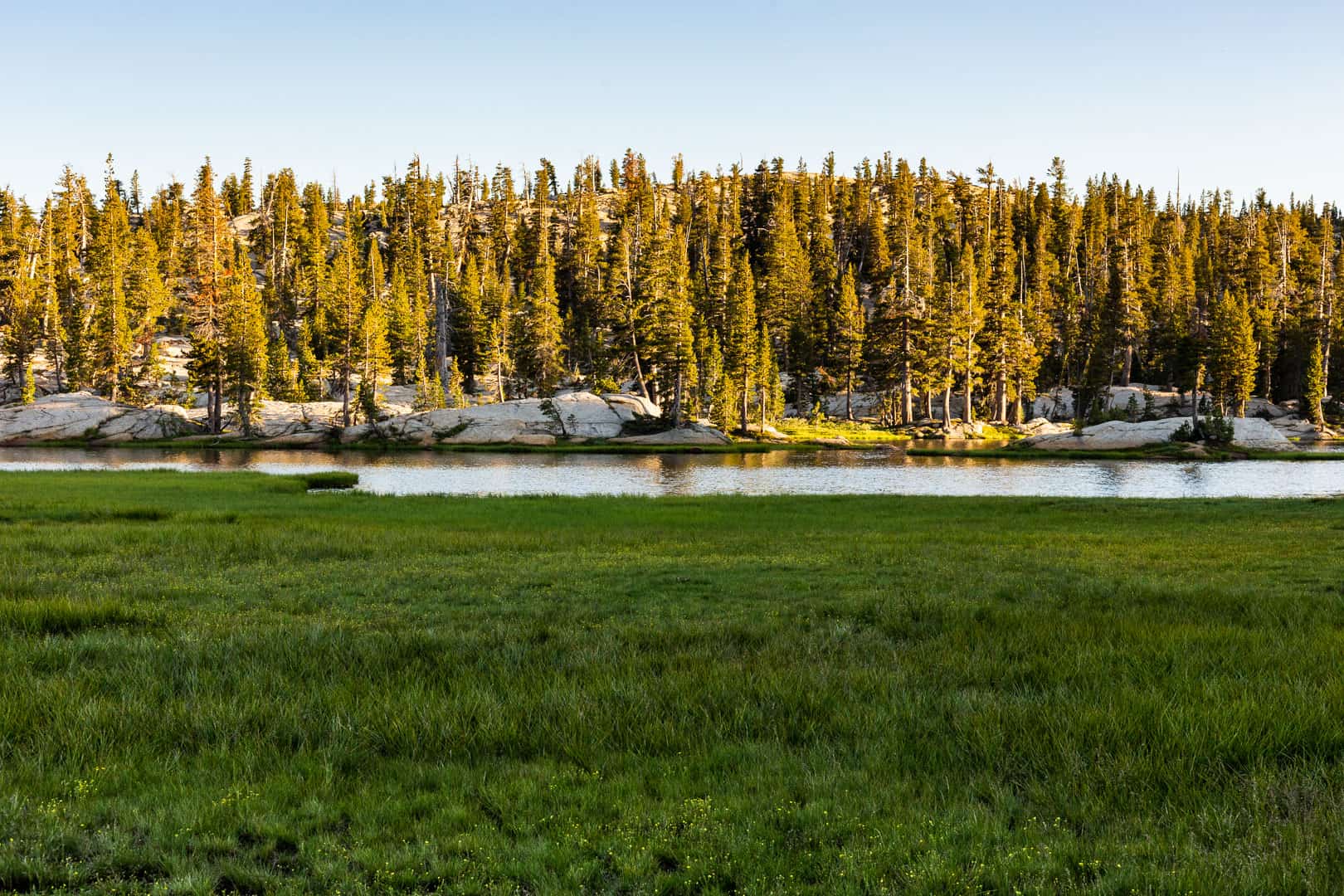


Deer Lake, around 11 miles from the Crabtree Trailhead, is an excellent place to set up camp — especially if you’re a fisherman. You’ll find rainbow trout rising to insects in the mornings and evenings, but be warned: they’re spooky and difficult to catch. The lake is situated in a canyon that runs from West to East, so the sun hits the water longer than usual as it sets, delaying dinner time for the fish. We caught a nice rainbow here that we wrapped in foil and cooked over a fire for dinner — it was outstanding. There are some nice campsites on the north side of the lake and plenty of other nice lakes nearby, including Wood Lake and the Buck Lakes.
Backpacking Emigrant Wilderness

Emigrant Wilderness offers spectacular campsites, like this one in the vicinity of Bear Lake. This is actually one of the worst sites I’ve had up here (relatively speaking of course) as it was more than a bit exposed. Just poke around, though, and you’ll find plenty of beautiful sites tucked into the pines.

My buddy Hergy at our campsite along Kennedy Creek. We used this spot as a basecamp to fish up and down the valley, including Kennedy Lake, where we had good luck catching some nice brown trout. Every evening we spent at this site, we’d walk down the bank to cook and eat dinner on the rocks along the creek. We’d dig into our freeze-dried beef stroganoff, with our rods strung and ready nearby, waiting for the trout to rise. And rise they did — we always managed to catch one or two before they stopped feeding.

An amazing campsite not far from a beautiful lake deep in the Emigrant Wilderness backcountry. We spent a couple of nights here, fishing in the mornings and evenings, and relaxing in the shade during the day. Firewood was ample, the stars were brilliant and the night was cool and quiet. Spots like these are a defining characteristic of this wilderness. Somehow, you just feel at home up here.

Camp along Piute Creek during our first night on the Emigrant Loop Trail. We had hoped to go a littler farther, but our legs were weary and we were in no rush.
Granite Everywhere

Take a peak at any decent map or satellite image of Emigrant Wilderness and you’ll quickly recognize that its most dominant feature is granite. This igneous rock is everywhere, in the shape of walls, ridges, domes and peaks. We often found ourselves exposed to the harsh high-country sun while hiking the Emigrant Loop Trail, or even climbing up to Kennedy Lake, so be sure to bring sunscreen, hats and buffs.
Fishing Emigrant Wilderness



Hergy fishes Kennedy Lake as smoke from the Donnell Fire drifts up and down the valley. The fishing was solid here — plenty of nice browns rising to dry flies. We figured the smoky, overcast conditions were in our favor, at least as far as the fishing was concerned. In general, trout fishing is excellent in Emigrant Wilderness. You do have to do a little research before you go, though, as many lakes are fishless, which is pretty much the norm in the High Sierra. This wilderness harbors trophy fish for those willing to trek deep into the backcountry.
Photo Essay
The Brown Trout
A brown trout is caught, cleaned and cooked to perfection in the Emigrant Wilderness backcountry in California’s Sierra Nevada.
Wood Lake

We spent our last night on the Emigrant Loop Trail here, at Wood Lake (the same lake in the pink hour photograph at the beginning of this page). If I had to do it all over again, I’d spend at least another night here. We had the most amazing campsite in a grove of pines, with good access to the lake, where I cast to constantly rising trout. Wood Lake has a reputation for giving up big rainbows, but I was skunked — my rusty casts were no match for the spooky fish, especially with the water this calm. I’ll get ’em next time.
Kennedy Valley

The view down Kennedy Valley in Emigrant Wilderness as a pyrocumulus cloud from the Donnell Fire looms beyond. I highly recommend an overnight trip into this scenic valley, lined by tall peaks along its entire length. You’ll see plenty of other backpackers, pack trains, and even some cows, as ranchers are allowed to graze their cattle in certain areas of the wilderness.
Resources
What to Take Backpacking in the High Sierra
Here’s everything I pack for a 3 or 4 night trip, minus food and water. I’d consider this list of base gear to be on the robust side — it will prepare you nicely for the unpredictability of the high country and guarantee a solid level of safety and comfort.
Know
Before
You Go
Every time I stop to pickup a permit for Emigrant Wilderness, the rangers warn me that the area is seeing more and more use. Please help keep this wonderful slice of the high country pristine and wild as you enjoy its splendor.
- Review the regulations for Emigrant Wilderness before entering the backcountry. Some highlights: Bear cannisters aren’t required (but recommended), campfires are legal up to 9,000 feet and dogs are welcome.
- Wilderness Permits are required to enter Emigrant Wilderness, but unlike other popular areas, there is currently no quota system in place (and they’re free). You can pick one up at the Summit Ranger Station in Pinecrest. Be sure to call ahead if you plan to pick up your permit outside their normal business hours.
- Dogs are allowed in Emigrant Wilderness — be sure to pack out their poop.
- Here’s some great info about the various trailheads providing access to Emigrant Wilderness.
- Here are some rough distances to destinations within Emigrant Wilderness, organized by trailhead.
- Here’s a high-res map of Emigrant Wilderness you can use for scouting and planning. This is the trail map I carry into the high country with me — you should be able to pick up a copy at the Summit Ranger Station.
- Like much of the rest of the High Sierra, the weather in Emigrant Wilderness can change in a flash. Days are warm, especially if you’re exposed to the intense, high-country sun. Nights will be cool. Bring adequate layers and always keep an eye (and ear) out for lightning and thunder.
- Check out these wilderness tips specific to the area.
- Remember to always practice the Seven Principles of Leave No Trace.
Know Before You Go
Every time I stop to pickup a permit for Emigrant Wilderness, the rangers warn me that the area is seeing more and more use. Please help keep this wonderful slice of the high country pristine and wild as you enjoy its splendor.
- Review the regulations for Emigrant Wilderness before entering the backcountry. Some highlights: Bear cannisters aren’t required (but recommended), campfires are legal up to 9,000 feet and dogs are welcome.
- Wilderness Permits are required to enter Emigrant Wilderness, but unlike other popular areas, there is currently no quota system in place (and they’re free). You can pick one up at the Summit Ranger Station in Pinecrest. Be sure to call ahead if you plan to pick up your permit outside their normal business hours.
- Dogs are allowed in Emigrant Wilderness — be sure to pack out their poop.
- Here’s some great info about the various trailheads providing access to Emigrant Wilderness.
- Here are some rough distances to destinations within Emigrant Wilderness, organized by trailhead.
- Here’s a high-res map of Emigrant Wilderness you can use for scouting and planning. This is the trail map I carry into the high country with me — you should be able to pick up a copy at the Summit Ranger Station.
- Like much of the rest of the High Sierra, the weather in Emigrant Wilderness can change in a flash. Days are warm, especially if you’re exposed to the intense, high-country sun. Nights will be cool. Bring adequate layers and always keep an eye (and ear) out for lightning and thunder.
- Check out these wilderness tips specific to the area.
- Remember to always practice the Seven Principles of Leave No Trace.
Emigrant Wilderness
Directions to Emigrant Wilderness
Coming from the West, the best way to get to Emigrant Wilderness is to take Route 108 up into the Sierra Nevada. Regardless of which trailhead you’re starting out from, you should be able to snag a permit at the Summit Ranger Station in Pinecrest. If you keep heading west on Route 108, you’ll hit Kennedy Meadows, Sonora Pass, and eventually pop out on the east side, just north of Mono Lake. Coming from the East, take Route 108 over Sonora Pass. Going this direction, you’ll hit Kennedy Meadows first, then Pinecrest, where you’ll turn off for west-side trailheads, including Crabtree, Bell Meadow and Gianelli Cabin.
Related Organizations
Stanislaus Wilderness Volunteers
The Stanislaus Wilderness Volunteers (SWV) are a diverse and growing team of Wilderness loving citizens from all walks of life who are united by a shared love of the idea of American Wilderness. The mission of Stanislaus Wilderness Volunteers is to preserve the wilderness character of designated public lands through education, example and coordinated effort in direct support of US Forest Service work in the Emigrant, Carson-Iceberg, and Mokolumne Wilderness areas of the Stanislaus National Forest.
Sierra Nevada Alliance
The Sierra Nevada Alliance’s mission is to protect and restore the natural environment of the Sierra Nevada for future generations while ensuring healthy and sustainable communities. We do this by strengthening the work of people and organizations committed to the environmental integrity of the Sierra Nevada.
Central Sierra Environmental Resource Center
Since 1991, the Central Sierra Environmental Resource Center (CSERC) has effectively served as the foremost environmental defender of more than 2,000,000 acres of forests, rivers, lakes, wetlands, roadless areas, old growth groves, scenic oak woodlands, and other precious areas within the Northern Yosemite region of the Central Sierra Nevada.
Tuolumne County Land Trust
The Tuolumne County Land Trust (TCLT) is one of many land trusts operating in California. It is the mission of the Tuolumne County Land Trust to perpetuate this area’s important landscape values, including agricultural, scenic, natural, cultural, and recreational lands. The main focus of the TCLT is working with the owners of private lands within Tuolumne County, who wish to protect the special features of their lands through voluntary private actions.

